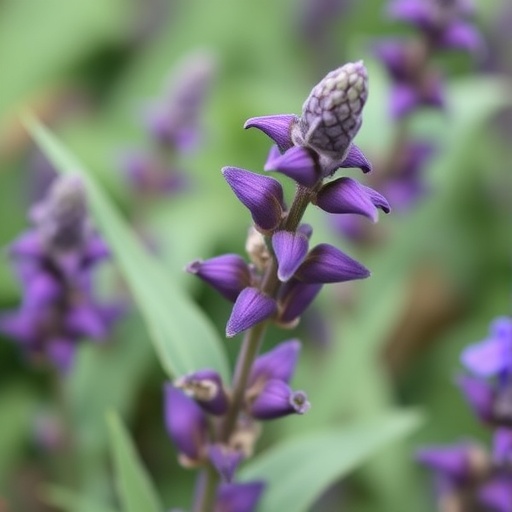In the intricate world of medicinal plants, Salvia miltiorrhiza, commonly known as Danshen, has emerged as a beacon of hope in the treatment of periodontitis, a prevalent and serious gum infection that, if left untreated, can lead to tooth loss and other serious health complications. Recent groundbreaking research has delved into the complex mechanisms through which this herb exerts its therapeutic effects. The study, conducted by Chen, Du, Guo, and their colleagues, takes an integrative approach, combining network pharmacology, molecular dynamics, and cellular assays to unveil the multifaceted role of Salvia miltiorrhiza in managing periodontitis.
Network pharmacology is a revolutionary approach that recognizes the multifarious interactions within biological systems. Traditionally, pharmacology has focused on single-target interactions, but the current findings suggest that Salvia miltiorrhiza operates through a network of biological interactions. This is particularly relevant in the context of periodontitis, where multiple pathways can be involved. By utilizing network pharmacology, the researchers were able to identify key active components within Salvia miltiorrhiza that interact with various molecular targets associated with periodontal disease.
The active constituents of Salvia miltiorrhiza, primarily including tanshinones and phenolic acids, possess significant anti-inflammatory and antioxidant properties. These phytochemicals play a crucial role in modulating inflammatory responses, which is essential in the treatment of periodontitis where inflammation is a hallmark feature. The study elucidates how these compounds inhibit pro-inflammatory cytokines and chemokines, thereby reducing the inflammatory burden within the periodontium, which is the supportive tissue surrounding the teeth.
Molecular dynamics simulations further augmented the understanding of the interactions between the active compounds and their targets. This computational technique allows researchers to visualize and predict how molecules behave over time and under different conditions. In the case of Salvia miltiorrhiza, the simulations demonstrated how certain active ingredients bind to target proteins, enhancing the drug-like properties of these natural compounds. The insights gained from molecular dynamics modeling not only provide a detailed picture of the interactions but also help in optimizing these compounds for enhanced therapeutic efficacy.
Cellular assays were instrumental in validating the computational predictions. In vitro experiments enabled the researchers to observe the actual effects of Salvia miltiorrhiza constituents on periodontal cells. These assays revealed significant reductions in cell apoptosis and enhanced cell viability in the presence of active components, suggesting a protective role against periodontal cellular stress and damage. The results from these experiments reinforce the notion that Salvia miltiorrhiza can effectively modulate biological functions critical to maintaining periodontal health.
Additionally, the research highlights the potential of Salvia miltiorrhiza to promote angiogenesis, the process of new blood vessel formation, which is essential for healing and restoring health to affected periodontal tissues. This is particularly important for patients with periodontitis, as compromised blood flow can hinder tissue repair and regeneration. The ability of Salvia miltiorrhiza extracts to enhance angiogenic pathways could pave the way for novel therapeutic applications in managing periodontal diseases.
The study not only emphasizes the pharmacological benefits of Salvia miltiorrhiza but also raises important questions about the broader implications of herbal medicine in modern health care. As interest in natural remedies grows, understanding the mechanisms by which these herbs exert their effects becomes crucial. The incorporation of advanced methodologies like network pharmacology and molecular dynamics in herbal research represents a significant shift towards discovery, which integrates traditional knowledge with modern scientific rigor.
Furthermore, the findings provide a robust framework for future studies aimed at exploring the comprehensive effects of Salvia miltiorrhiza on various oral health conditions. The versatility of this herb opens pathways for investigating its role beyond periodontitis, potentially addressing other inflammatory conditions within the oral cavity. As researchers continue to unlock the secrets of Salvia miltiorrhiza, it may soon be recognized not just as a traditional remedy, but as a cornerstone in contemporary periodontics.
In conclusion, this research stands as a testament to the power of integrative science in uncovering the healing potential of Salvia miltiorrhiza. By bridging ancient wisdom with cutting-edge technology, it lays down a solid foundation for the future of herbal medicine in dentistry. The complex interplay of herbs, cellular interactions, and therapeutic outcomes invites a new era of treatments that are not only effective but also rooted in historical use. As more studies emerge, Salvia miltiorrhiza may very well become a staple in the therapeutic arsenal against periodontitis, reshaping the landscape of dental health.
As we pivot toward examining the supporting references for this groundbreaking work, the implications of Salvia miltiorrhiza’s application in clinical settings remain a topic of considerable interest. The study, titled “Mechanism of Salvia miltiorrhiza in the treatment of periodontitis: integrative analyses via network pharmacology, molecular dynamics, and cellular assays,” presents a critical look at how traditional herbal medicine can inform and complement modern therapeutic strategies.
Overall, the convergence of ancient healing practices with modern scientific methods has the potential to transform how we understand and treat periodontal diseases. The journey of Salvia miltiorrhiza from traditional use to contemporary relevance is an exciting narrative, one that is likely to continue unfolding in the years to come.
Subject of Research: Mechanisms through which Salvia miltiorrhiza aids in the treatment of periodontitis.
Article Title: Mechanism of Salvia miltiorrhiza in the treatment of periodontitis: integrative analyses via network pharmacology, molecular dynamics, and cellular assays.
Article References:
Chen, Y., Du, S., Guo, Y. et al. Mechanism of Salvia miltiorrhiza in the treatment of periodontitis: integrative analyses via network pharmacology, molecular dynamics, and cellular assays. BMC Complement Med Ther 25, 291 (2025). https://doi.org/10.1186/s12906-025-05040-4
Image Credits: AI Generated
DOI: 10.1186/s12906-025-05040-4
Keywords: Salvia miltiorrhiza, periodontitis, network pharmacology, molecular dynamics, cellular assays, herbal medicine, inflammation, angiogenesis.




